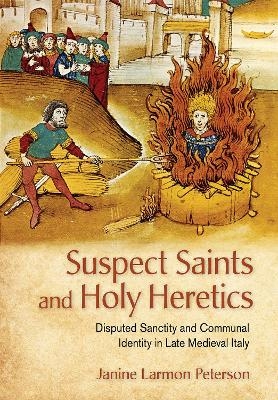
Suspect Saints and Holy Heretics
Disputed Sanctity and Communal Identity in Late Medieval Italy
Seiten
2019
Cornell University Press (Verlag)
978-1-5017-4234-7 (ISBN)
Cornell University Press (Verlag)
978-1-5017-4234-7 (ISBN)
In Suspect Saints and Holy Heretics Janine Larmon Peterson investigates regional saints whose holiness was contested. She scrutinizes the papacy's toleration of unofficial saints' cults and its response when their devotees challenged church authority about a cult's merits or the saint's orthodoxy. As she demonstrates, communities that venerated...
In Suspect Saints and Holy Heretics Janine Larmon Peterson investigates regional saints whose holiness was contested. She scrutinizes the papacy's toleration of unofficial saints' cults and its response when their devotees challenged church authority about a cult's merits or the saint's orthodoxy. As she demonstrates, communities that venerated saints increasingly clashed with popes and inquisitors determined to erode any local claims of religious authority.
Local and unsanctioned saints were spiritual and social fixtures in the towns of northern and central Italy in the thirteenth and fourteenth centuries. In some cases, popes allowed these saints' cults; in others, church officials condemned the saint and/or their followers as heretics. Using a wide range of secular and clerical sources—including vitae, inquisitorial and canonization records, chronicles, and civic statutes—Peterson explores who these unofficial saints were, how the phenomenon of disputed sanctity arose, and why communities would be willing to risk punishment by continuing to venerate a local holy man or woman. She argues that the Church increasingly restricted sanctification in the later Middle Ages, which precipitated new debates over who had the authority to recognize sainthood and what evidence should be used to identify holiness and heterodoxy. The case studies she presents detail how the political climate of the Italian peninsula allowed Italian communities to use saints' cults as a tool to negotiate religious and political autonomy in opposition to growing papal bureaucratization.
Open Access edition funded by the National Endowment for the Humanities
In Suspect Saints and Holy Heretics Janine Larmon Peterson investigates regional saints whose holiness was contested. She scrutinizes the papacy's toleration of unofficial saints' cults and its response when their devotees challenged church authority about a cult's merits or the saint's orthodoxy. As she demonstrates, communities that venerated saints increasingly clashed with popes and inquisitors determined to erode any local claims of religious authority.
Local and unsanctioned saints were spiritual and social fixtures in the towns of northern and central Italy in the thirteenth and fourteenth centuries. In some cases, popes allowed these saints' cults; in others, church officials condemned the saint and/or their followers as heretics. Using a wide range of secular and clerical sources—including vitae, inquisitorial and canonization records, chronicles, and civic statutes—Peterson explores who these unofficial saints were, how the phenomenon of disputed sanctity arose, and why communities would be willing to risk punishment by continuing to venerate a local holy man or woman. She argues that the Church increasingly restricted sanctification in the later Middle Ages, which precipitated new debates over who had the authority to recognize sainthood and what evidence should be used to identify holiness and heterodoxy. The case studies she presents detail how the political climate of the Italian peninsula allowed Italian communities to use saints' cults as a tool to negotiate religious and political autonomy in opposition to growing papal bureaucratization.
Open Access edition funded by the National Endowment for the Humanities
Janine Larmon Peterson is Professor of History, Coordinator of the Medieval and Renaissance Studies Program, and Director of the Honors Program at Marist College. She is the Medieval Europe Editor for the Database of Religious History, and has published in Past & Present, Scriptorium, Traditio, and Viator.
List of Tables and Illustrations
Acknowledgments
Abbreviations
Introduction
1. Tolerated Saints
2. Suspect Saints
3. Heretical Saints
4. Holy Heretics
5. Economics, Patronage, and Politics
6. Anti-Inquisitorialism to Antimendicantism
7. Papal Politics and Communal Contestation
8. Methods of Contesting Authority
Conclusion
Bibliography
Index
| Erscheinungsdatum | 04.11.2019 |
|---|---|
| Zusatzinfo | 1 Maps; 2 Charts; 3 Halftones, black and white |
| Verlagsort | Ithaca |
| Sprache | englisch |
| Maße | 152 x 229 mm |
| Gewicht | 907 g |
| Themenwelt | Geschichte ► Allgemeine Geschichte ► Mittelalter |
| Geisteswissenschaften ► Geschichte ► Regional- / Ländergeschichte | |
| Religion / Theologie ► Christentum ► Kirchengeschichte | |
| ISBN-10 | 1-5017-4234-5 / 1501742345 |
| ISBN-13 | 978-1-5017-4234-7 / 9781501742347 |
| Zustand | Neuware |
| Informationen gemäß Produktsicherheitsverordnung (GPSR) | |
| Haben Sie eine Frage zum Produkt? |
Mehr entdecken
aus dem Bereich
aus dem Bereich
eine neue Geschichte des Mittelalters
Buch | Hardcover (2023)
C.H.Beck (Verlag)
CHF 53,20
Geschichte einer Augsburger Familie (1367-1650)
Buch | Softcover (2024)
Kohlhammer (Verlag)
CHF 47,60


